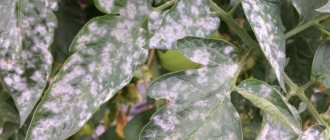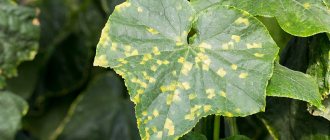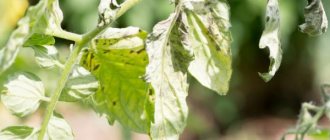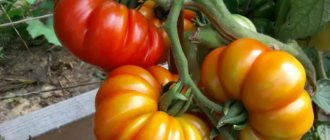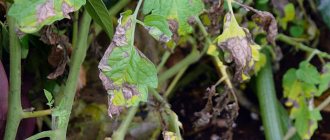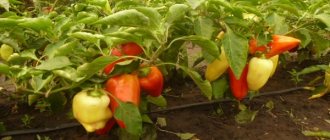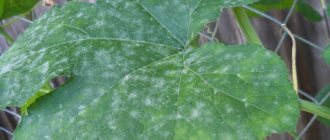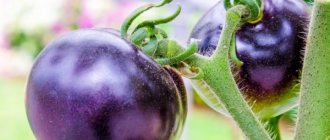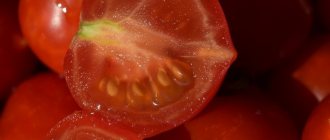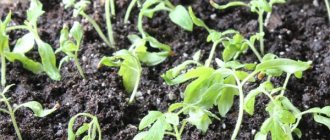Symptoms
The main symptom of the disease is spots on leaves, stems, and fruits. The lower leaves are the first to become marked. The spots have a dark brown color, distinct outlines and a rough coating (these are conidia). The diameter of the marks is from 4 to 14 mm.
On the stems and petioles the spots are elongated, almost black. The marks on the fruit are depressed, dark with a velvety surface, and large. The spot may cover up to a quarter of the surface of the fruit or look like a scattering of small spots collected in groups on the surface of a ripe tomato.
Fruits with spots are unsuitable for food, since the mycelium covers all the pulp and changes its taste. The infection quickly spreads from diseased bushes to healthy ones. Foci of infection form in the garden bed. The epidemic threatens mass death of tomatoes and complete loss of the harvest.
Tomato brown spot or cladosporiosis, leaf mold
The causative agent is the fungus Fulviafulva (Cjjke) Ciferri (syn. Cladosporium fulvum). The incubation period is 10-12 days. Spores persist at sub-zero temperatures and overwinter in soil and plant debris. All green mass is affected, less often fruits. The first signs of tomato disease are round or oval spots on the leaves of a dirty brown color, noted on the plates of the lower tier. With mass distribution, brown spot lesions merge with each other. Over time, the leaves of our tomatoes turn yellow, dry out, curl, and die - brown spotting appears in all its glory. Infection occurs during the flowering and ovary phase, after which the infection spreads to the upper tiers. As a rule, infection occurs in rainy, damp weather, the best time for mycelium growth. When humidity is below 70%, the spores do not die, but the disease does not spread.
READ ALSO: We treat strawberries with iodine or all the pros and cons of pharmaceutical agrochemicals
Brown rot of tomatoes, the fruits themselves - lesions at the base, near the stalk - the main difference from blossom end rot, etc. Reasons: high humidity, dampness, high planting density, poor ventilation in greenhouses.
Measures to combat brown spot:
- fungicides based on mancozeb, metalaxyl - Ridomil Gold MC, Acrobat MC, etc., antifungal agents such as foundationol, copper preparations, etc. strictly in accordance with the instructions.
- Treatment before flowering is recommended, the last treatment 3 weeks before harvesting. Frequent treatments are not recommended; if there is no effect, then it is easier to lose the battle for the harvest than to harvest healthy vegetables that are oversaturated with chemicals.
Prevention: No thickening, watering at the roots, between rows, drip - sprinkling, especially in the evening - a source of dew in the morning, which means dampness, excess humidity. In greenhouses - ventilation, disinfection of surfaces with a solution of copper sulfate, treatment with fungicides. Treatment with Fitosporin is suitable for prevention. If brown (olive) spot is present in greenhouses, the top layer of soil is changed, at least 10 cm; in open ground - deep digging, sowing of green manure, fungicides for the soil.
Fighting methods
Chemicals, biological agents and folk recipes are used against fungus.
Treatment with biological drugs
- Trichodermin - dusting seeds, soaking seedling roots in mash, adding to the soil when planting seedlings, spraying during the growing season.
- Fitolavin - spraying at any phase of growth and development with an interval of two weeks, but no more than 2 times in 2 months.
- Fitosporin – seed treatment, watering the soil before planting seedlings, spraying vegetative and fruit-bearing plants.
- Alirin - application to the soil at the root when planting seedlings.
Use of chemicals
Fungicides containing Cuprum or Triazole work well against the disease. Systemic drugs give good results, but the dosage and frequency of treatments must be strictly observed.
Liquid in ampoules and vials containing Difenoconazole. Effective in the early stages of disease development. Dosage 10 ml per 10 liters of warm water.
Quadris
Contains azoxystrobin (a broad-spectrum fungicide), protects against infection, late blight and powdery mildew.
Used for prevention or treatment in the early stages of fungal development.
The drug prevents spore germination and slows down the development of fungal hyphae.
It has a systemic effect, penetrates the leaf blade and protects it on both sides.
The maximum number of treatments is 5, the waiting period is 3 days.
Ditan (analogue of Profit)
Contact fungicide used to combat brown spot in an advanced stage. Working substance Mancozeb. This powder must be diluted in water and sprayed on growing bushes. Dosage 20 g per 10 liters of water, 3 treatments, waiting period 20 days.
Folk remedies
There is no traditional treatment for the disease. Having noticed leaves with spots, you need to tear them off and burn them, and spray the bush with an infusion of ash. Alkalinization with ash strengthens plant tissues, saturates them with potassium, increasing resistance to infectious agents. However, no untested remedy will prevent the further spread of the disease.
Preventative measures and treatment
Use of chemical pesticides
To control the development and spread of Alternaria blight, fungicidal preparations from the groups of strobilurins, morpholines, triazoles, inorganic substances and copper compounds are used ( see summary table of fungicides ).
Among the recommended drugs are Quadris, Signum, Skor , Oksikhom, Rayok, Abiga-Pik, Ridomil Gold, Acrobat, Polyram, Ordan, etc.
You can use copper sulfate. The working solution is prepared from a ratio of 20 g. copper sulfate, 200 gr. soap shavings, green soap or other adhesive, 10 l. water.
Treatment is carried out by spraying - the first time when the first signs of the disease are detected, the second and subsequent times with an interval of 10-14 days. The number of treatments is at least 2-3 times until the disease is localized.
Use of biological pesticides
The use of biological products is a modern trend in protecting plants from diseases and pests. Tomato Alternaria can also be controlled by using biofungicides. Among the most used are “Fitosporin-M” , “Alirin”, “Gamair”, “Trichodermin” , etc. The soil is watered before sowing seeds or seedlings and/or diseased plants are sprayed during the growing season.
Alternaria blight is a common disease in nightshade crops.
Agrotechnical protection measures
Agrotechnical measures to protect tomatoes from Alternaria blight (dry spotting) include:
- pre-planting treatment of seed material with disinfectants and immunostimulants “Epin”, “Zircon”, etc.;
- ensuring crop rotation;
- compliance with watering and ventilation regimes , especially when growing tomatoes indoors;
- mandatory spring preparation of the greenhouse before growing tomato seedlings (for more details, see the material “Processing a greenhouse in spring - EIGHT stages of work and what to consider first” );
- selection of tomato varieties resistant to the pathogen (varieties Lyana, Luch, Sanka and hybrids Aurora, Alex, Nadezhda, etc.).
Prevention measures
Dry rot is a disease that is easier to prevent than to treat.
To help prevent the problem:
- pre-sowing treatment of seeds in fungicide or manganese;
- dusting seeds with Trichodermin;
- crop rotation - tomatoes need to be returned to their old place no earlier than after 4 seasons;
- separate cultivation of nightshade crops, since the disease passes from potatoes to tomatoes and vice versa;
- mandatory ventilation of the greenhouse in hot weather so that water does not stagnate in the air;
- loosening the soil after watering or using mulch - this reduces air humidity;
- compliance with the planting scheme;
- disinfection of a greenhouse before planting seedlings using sulfur bombs
- clearing the beds of plant debris in the fall and placing them in a compost heap, where the spores will die;
- selection of resistant varieties.
Characteristics of the disease
Alternaria blight on tomatoes and other vegetable crops affects all above-ground parts, spreading from the bottom to the very top. Ideal conditions for the development of the Alteria fungus are long rains, heavy dew, with high humidity in the greenhouse, when the daytime temperature is +22 and above, and there are differences in night temperatures. More often, the disease manifests itself in close proximity to other nightshade crops - potato macrosporiosis will quickly spread to tomatoes, eggplants and peppers.
Primary infection always occurs through soil contaminated with spores, often during the seedling period. The appearance of the first signs of the disease will be noticeable immediately after planting the seedlings in greenhouses and greenhouses.
The characteristics of tomato Alternaria blight and its symptoms are as follows:
- through wounds on the stem and damaged leaves, fungi penetrate into the tissues and oval dry brown spots with a small light rim, 3-5 mm in size, appear on the leaf blades, covered on top with a velvety moldy coating of olive color;
- Gradually, dense spots of tomato macrosporiosis increase to 17-20 mm, spread across the leaf, around them the plate turns yellow, after a while the leaf dries out;
- at the same time, as the disease develops, concentric spots with a depressed surface also appear on the stems;
- the same spots with a black sooty coating appear on the stalk;
Favorable factors for the development of tomato Alternaria blight
Favorable conditions for the spread of the causative agent of tomato Alternaria are: a humid environment and high ambient temperature.
The development of Alternaria tomato blight is facilitated by frequent heavy rains and heavy dew in hot summers, as well as sharp changes in day and night temperatures, when high temperatures suddenly change to low. Alternaria infection is also facilitated by: mechanical damage to the crop, contaminated soil and contaminated seeds or seedlings.
Macrosporiasis - when, why and how it occurs
The causative agent of the disease is the imperfect fungus Macrosporium (macrosporium), after which it is named. In addition to tomatoes, this fungus especially loves potatoes.
Most often, the infection affects tomato plants that are weakened due to a lack of nutrients or poor agricultural practices. Another risk factor is cracking of the skin of the fruit and any mechanical damage to the plants (sunburn, punctures from insects, careless handling during care), through which it is easier for fungal spores to penetrate inside.
The earliest appearance of symptoms of macrosporiosis in open ground can appear as early as 10-14 days after planting the seedlings. The development of the disease is favored by humid, warm weather (+20-24°C), especially with a constant change of rainy and sunny days and/or with heavy dew.
The fungus overwinters in the state of spores and mycelium in the upper layers of the soil and on the remains of infected plants, maintaining viability for up to three years, and in the spring it infects new plants, “moving” along them from the bottom up, spreading with the help of wind and drip moisture.
Symptoms of tomato Alternaria blight
Tomato Alternaria blight appears in the form of spots that can cover various parts of the plant. The spots are dark brown, almost black, and increase in size as the infection progresses. The spots have a concentric structure and can reach up to 1.5 cm in size. With high air humidity, a dense black coating of sporulation can form on the spots.
When severely affected by Alternaria blight, the tomato leaves die, the stems and petioles dry out and then break, and the tomatoes fall off without having time to ripen, or, conversely, ripen prematurely and have a small mass. The fungus is also able to penetrate deeply and infect the seeds, after which they darken and lose their germination capacity.
Biology and cause of the disease
The causative agent of tomato disease Alternaria (dry spot) is the fungus Alternaria solani Sorauer . The fungus affects all vegetative parts of the plant - stem, leaves and fruits.
The peculiarity of this fungus is that it places its mycelium inside the structure of plant tissues. The conidia of the fungus are club-shaped, multicellular, light gray in color, size 90–140 x 12–20 µm.
The shape of Alternaria spots is concentric, the color is dark brown.
Development cycle of tomato Alternaria blight
The source of the primary infection of tomato Alternaria blight can be seeds, and the source of the secondary infection can be dry remains of affected fruits in the soil and dry affected plant residues after harvest.
The first symptoms of the disease appear on the lower leaves of tomatoes in the form of brown spots. Over time, the spots grow, merge and the leaves die. Also, when the disease occurs, oval zonal spots appear on the stem, which causes dry rot of the stems. Tomato fruits are affected less frequently. At the same time, slightly depressed, dark round spots form on them, most often near the stalk.
Macrosporiasis. Description of the disease.
It is excited by microorganisms classified by experts in the classification of objects of the organic world as the genus Macrosporium. It is assigned to the family Pleosporaceae, which, along with other 25 families, is covered by the order Pleosporales. This order is included in the class Dothideomycetes, and that class is included in the division Ascomycota, or Ascomycetes, or Marsupial fungi.
The genus Macrosporium (in Russian it can be called a little shorter - Macrosporium) first appeared on the “tablets” of terrestrial biology in 1832 and, as voluminous reference books show, was replenished with new species until 1975 inclusive, so that it currently contains more than 350 species ( taking into account all options and forms).
Species epithets among the “sons” of a genus are often able to remind an attentive person of specific higher plants. Here are a “damn dozen” examples - please compare them yourself:
— Macrosporium abutilonis and the word Abutilon (the name of the genus Abutilon, or Kanatnik); — Macrosporium acalyphae and Acalypha (the name of the genus Akalifa, or Foxtail); — Macrosporium agaves and Agave (name of the genus Agave); — Macrosporium amaranthi and Amaranthus (the name of the genus Amaranth, or Shchiritsa); — Macrosporium amygdale and Amygdalus (name of the subgenus Almond); — Macrosporium avenae and Avena (genus name Oats); — Macrosporium brassicae and Brassica (name of the genus Cabbage); — Macrosporium cheiranthi and Cheiranthus (genus name Zheltushnik); — Macrosporium oleandri and the phrase Nerium oleander (the name of the species Common Oleander); — Macrosporium papaveris and the word Papaver (the name of the genus Poppy); — Macrosporium phaseoli and Phaseolus (the name of the genus Bean); — Macrosporium sesame and Sesamum (genus name Sesame, or Sesame); — Macrosporium violae and Viola (name of the genus Violet)…
It seems quite natural to assume that all plants that are easily associated with similar species epithets should be (at least to a small extent) “familiar” with macrosporiosis. However, it is not confirmed by studying the sources of relevant information. They mainly talk about only three cultures:
A) subspecies and varieties of Potato, or Nightshade (Solanum tuberosum), as well as any varieties of Tomato (Solanum lycopersicum) can develop macrosporiosis “thanks to” the fungus Macrosporium solani. At the same time, only a few authors dare to casually add: “and other plants of the Solanaceae family”;
B) Cotton plants [exactly those 4 species from the genus Gossypium that are spinning: Gossypium arboreum (Tree cotton, also known as Indochinese), Gossypium barbadense (Barbados cotton, also known as Peruvian), Gossypium herbaceum (Herbaceous cotton, also known as Guza) and the most famous in the USSR, Gossypium hirsutum (Common cotton, also known as Mexican, also known as shaggy, also known as shaggy)] are “victims” of the fungi Macrosporium gossypii and/or Macrosporium gossypinum.
The disease has a couple more names in Russian, reflecting its main symptom: “brown spotting” and “dry spotting”.
Foreign reports confidently state: Macrosporium solani is nothing more than an “alternative name” - a synonym for the name of the fungus Alternaria solani. Based on this premise, should the disease described here (as applied to Solanaceae) be called “alternaria”? - No need! There is a special article for Alternaria in our Garden Encyclopedia.
Treatment of tomato Alternaria
Alternaria is considered a very dangerous disease that spreads very quickly. If treatment is not started in time, it can affect the entire crop and cause the death of up to 85% of the entire tomato crop. Therefore, it is very important to notice the first symptoms of the disease in time - the appearance of spots on any parts of the plant.
When the first signs of tomato Alternaria blight appear, it is necessary to begin treatment immediately. To treat plants, it is recommended to use chemical protection agents - contact and systemic fungicides. Contact fungicides are considered the most effective.
It is recommended to treat tomatoes with a fungicide every 2 weeks. During the season, you can spray the crop no more than 3-4 times, observing the regulations for the use of drugs.
How and with what to treat
Despite its seriousness, macrosporiasis is treatable. Experienced gardeners have many effective recipes in their arsenal.
Chemicals
At the first signs of dry spotting, you should immediately spray the tomato bushes with one of the following products:
- 0.4% solution of copper oxychloride (oxychloride): 40 g of the drug per 10 liters of water. To increase the adhesion of the solution to the leaves, it is recommended to add a little 1% milk. Solution consumption – no more than 1 liter per 10 m2.
- 1% Bordeaux mixture: dissolve 100 g of copper sulfate and 100-150 g of slaked lime separately in 1 liter of hot water, bring each solution to 5 liters, strain the lime suspension and add the copper sulfate solution. Consumption – 1.5-2 liters per 10 m2.
- 0.4% zineb solution: dilute 40 g of powder in 0.5 liters of water, mix thoroughly, bring the volume to 10 liters. The consumption of the working solution is about 1 liter per 10 m2.
Complex fungicidal agents are also suitable for processing tomatoes: “Polichom”, “Polycarbacin”, “Ridomil”. They should be used according to the instructions.
When working with all chemicals, you must follow safety requirements: use gloves and respirators, wash your hands and wash your clothes after finishing work.
Spraying with chemicals is carried out 3-4 times per season.
Important! The use of fungicidal preparations should be stopped no later than three weeks before harvest.
Traditional methods
For those who prefer natural remedies, there are traditional ways to combat macrosporiasis:
- Infusion of garlic and hot pepper. Grind 200 g of garlic in a blender or meat grinder, add 3 liters of water and leave in a dark place for two days. Strain the infusion, add 0.5 teaspoon of ground bitter red pepper. Spray the tomatoes with the resulting extract once every ten days.
- Iodine solution. Dissolve 20 drops of iodine in 8 liters of water; to improve the retention of the solution on the foliage, add a little dishwashing detergent. Spray tomatoes once a week when signs of fungal infection appear.
- Mullein infusion. Place 1 kg of rotted hay and 3 kg of fresh cow manure in a container. Pour 10 liters of water. Insist for three days. Then strain the infusion and treat plants with signs of disease 1-2 times a week.
Agrotechnical techniques
If macrosporiosis has significantly affected tomato bushes, you can try to save the crop. To do this, you need to remove the unaffected fruits and put them to ripen, after dipping them in hot (60 ° C) water and drying them.
Prevention of tomato Alternaria blight
To prevent Alternaria in tomato, the following measures are recommended:
- compliance with crop rotation,
- thorough cleaning and destruction of all plant residues from the soil after harvesting, as they can be sources of infection,
- carrying out soil disinfection,
- use of disease-resistant varieties,
- complete mineral fertilizer of the crop with increased doses of potassium,
- destruction of infected plants,
- spraying the crop with biological preparations before signs of the disease appear.
© 2021 Crop Protection Company Sales of plant protection products
Moscow, Kyiv highway, BP Rumyantsevo +7 E-mail:
What is Alternaria tomato blight and how to defeat it
A common and quite harmful disease of tomatoes, potatoes and other garden plants, Alternaria annually destroys from a quarter to half of the crop.
Alternaria tomato blight is also known under the following names: dry, brown, early, zonal, concentric spot, macrosporiosis. The causative agent is the simplest mold fungi.
Alternaria alternata and its varieties, of which there are more than 200 species, affect almost all known garden and cereal crops, flowers, trees, rapeseed, tobacco, and cotton. The harvest may be completely ruined.
Ask and receive useful advice from professional gardeners and experienced summer residents.>>
Alteria fungi also parasitize Formica ants, and also significantly complicate the course of asthma in humans and cause such dangerous diseases as allergic and hypersensitivity pneumonitis, exogenous alveolitis.
Alternaria blight or dry spot of tomato. Ways to fight
The main problem for gardeners is plant diseases. Tomatoes are also susceptible to various diseases, like other garden crops. Despite the fact that there are varieties that are maximally resistant to various types of diseases, sooner or later the plantings will have to be treated. One of the serious diseases that can destroy the entire harvest is Alternaria or Alternaria, as it is also called.
It has many names:
- macrosporiosis,
- dry spotting,
- brown spotting,
- dry disease.
This tomato disease is very common and most harmful . At first it appears as white, brown or other colored dry spotting. Occurs on tomatoes during the growing season during different periods of fruit development.
It is very easy to determine that the disease has already begun to develop on tomato bushes because it covers not only the fruits, but also the leaves and stems. The widespread spread of the disease on tomatoes breaks out at the very initial stages - on the ovaries of the future harvest.
Description
The cause of the disease is the microorganism alternatio solani sorauer. It can live on any nightshade and affects above-ground organs, starting with the lower ones. The disease has other names:
- brown spotting;
- dry spotting.
After late blight, this is the most widespread and dangerous disease of nightshades.
Primary signs of Alternaria blight
The primary signs of dry spotting or Alternaria blight are dry spots on the lower leaves of plants. Not very quickly, but persistently, the Alternaria disease spreads throughout the entire plant on which it has fallen, and gets to the very top leaves of the tomato bush. In those areas where the spread of tomato disease is noticeable, swelling is initially brown in color and small in size, no more than 4-7 mm. But that's first. After this, the value grows and becomes 10-15 mm. Externally, the type of damage these diseases look like is an oval-shaped plaque with a black velvet tint characteristic of this disease.
general characteristics
Alternaria blight ( Early Blight of Tomato ) is a fungal disease that affects tomatoes, eggplants, potatoes and other nightshade crops in open and closed ground.
External signs of damage to tomato fruits due to Alternaria blight
The disease is widespread in all areas where these crops are grown. Geography of distribution - Ukraine, Moldova, North Caucasus. The disease is widespread in the Far East, Eastern Siberia, Southern Urals, throughout the central European part of Russia, in the Volga region, and in the northwestern regions of Russia.
The disease has several names - Alternaria blight, dry spotting, macrosporiosis, Alternaria spotting, zonal spotting , etc.
Biology of development of Alternaria blight in tomatoes
The initial symptoms of the disease will appear on tomato leaves during the flowering period of the very first tassels. Then the spores of the pathogenic fungus move to the surface of the fruit, not germinating until the fruit ripens and barely noticeable damage appears. Favorable conditions for the development of this tomato disease are high air temperature and good humidity. If these conditions are created, then this disease begins to grow along with the tomatoes .
If there is a natural alternation between dry and hot weather and heavy dew and precipitation, then the disease will intensify even more. What is especially dangerous is that even after autumn and off-season harvesting, the spores of this fungus remain in the soil and pose a threat to subsequent crops.
The pathogenic fungus spends the winter in the form of mycelium and conidia . It develops on particles of plants affected by it remaining from previous seasons, which are located on the surface of the soil and also take root in its upper layers. Dry remains of fruits infected with it also act as “guardians” of this microorganism.
Interestingly, the fungus does not live in rotten organic remains. the primary source of plant infection .
Causes of the disease
Dry spotting appears in greenhouses and on ridges with plantings under certain conditions:
- high air temperature;
- high humidity;
- waterlogging of the soil;
- heavy dew.
Read also: Potato variety “Melody”: characteristics, secrets of successful cultivation
The fungus develops in plant debris, survives the cold period in the form of conidia and mycelium. Transmitted through infected seeds.
The causative agent is the deuteromycete fungus Alternatio solani Sorauer, which does not reproduce in rotten plant debris.
In favorable conditions, late blight appears earlier. It differs from late blight in that the spots remain dry even in heavy rains. In some years, severe outbreaks of the disease were observed in the North-West of the Russian Federation and the Far East.
Risk factors are:
- differences in night and day temperatures;
- heavy dew;
- mechanical damage to fruits.
There is a type of Alternaria blight that affects not only mature, but also green tomatoes.
Ways to protect against Alternaria blight on tomatoes
There are several types of protective agents that can prevent or even stop tomato Alternaria and become a treatment for this unpleasant disease . There are biological and chemical agents.
Biological agents
It is recommended to spray the affected plants with the special drug Trichodermin. It is sprayed on leaves and stems in the spring - in April and May, when the appearance of the disease becomes more likely.
Chemicals
One of the most important and effective preventive sprayings of these plants is spraying the drug Quadris on them.
It can be used not only as a prophylactic agent, but also as a therapeutic drug at the moment the very first sign of the disease appears. In order to protect tomatoes, it is also recommended to spray the fruits with a solution of a special preparation “Acrobat” or “Ordan”.
Integrated Protection
At the moment, integrated tomato protection seems to be the most reliable. It combines all methods of combating these harmful spores.
Integrated protection includes the following methods of control and treatment of tomatoes:
- agrotechnical,
- chemical,
- biological.
It fights pests and weed diseases. Based on constant and extensive monitoring of disputes, diseases, and pests. The main condition for the use of this type of protection is strict dosing and the validity of the use of selected chemical and biological methods of protecting fruit crops.
Alternaria blight of tomatoes. dry spotting (zonal spotting) of tomato (alternaria solani sorauer.)
Tomato Alternaria blight, or dry spot (zonal spot) of tomato (Alternaria solani Sorauer.) is a fungal disease that affects tomatoes and other plants of the Solanaceae family.
Alternaria tomato blight or tomato dry spot affects almost all above-ground parts of plants: stems, leaves, petioles, stalks, sepals and tomato fruits. First of all, the lower leaves are affected, on which large, up to 5-15 mm in diameter, dark brown (almost black) spots are formed, covered with a velvety coating of sporulation, with clearly defined zoning. With increased humidity, the spots merge, covering the leaf blade, and the leaf dies. Dark elongated spots with a velvety coating form on the stems and petioles, and black depressed spots appear on the fruits. The mycelium of the fungus grows in the tissues of the plant, and the plaque formed on the surface is conidiophores with conidia. Conidia are obclavate, dark, multicellular, with longitudinal and transverse septa. With their help, the fungus spreads during the growing season. Conidia and mycelium can survive in the soil and on affected plant debris and then serve as a source of infection. The causative agent of tomato dry spot disease can affect not only tomatoes, but also other plants of the Solanaceae family, for example, eggplant and potatoes.
Alternaria tomato blight was first discovered in 1901 in the Kursk region. Currently, the disease is widespread in the tomato growing area. Alternaria blight of tomatoes causes the greatest harm in Sakhalin, the Far East, Eastern Siberia, Moldova, Belarus, Ukraine, Orel, Tambov, Volgograd, Belgorod, Smolensk, Saratov, Rostov, Astrakhan regions, Uzbekistan, Kabardino-Balkaria, where the number of affected of plants can reach 100% in some years, leading to a 50% reduction in yield.
For the development of tomato Alternaria, the optimal temperature is 24-30°C, with a 3-4 day incubation period. Alternating rain or night dew with hot, dry weather contributes to the active development of the fungus.
The disease leads to a significant reduction in yield (20-50%), which is caused by premature leaf fall.
To protect against Alternaria blight or dry spot of tomato
- destroy plant debris;
- after harvesting, carry out deep autumn plowing;
- disinfect soil in greenhouses;
- observe crop rotation and return the tomato to its original place no earlier than after 3 years - the best predecessors for tomato are perennial herbs, legumes, cucumber, onion;
- For tomatoes, it is advisable to apply complete mineral fertilizer with increased doses of potassium;
- Spray plants with fungicides during the growing season - you need to start spraying when the first spots of Alternaria blight appear on the leaves and repeat them after 10-14 days. You can spray tomato plants with fungicides 3-4 times during the season, following the regulations for their use. The most effective fungicides of systemic contact action are Ridomil Gold MC 68WG (60 g per 10 l of water), Acrobat MC, 69% pp. n. (50 g per 10 l), quadris 250SC (15 ml per 10 l), Thanos, 50% c. g. (15 g per Yul), tattu, 55% c.s. (60 ml per 10 l);
- cultivate resistant varieties;
Video. Biological fungicide for the control of Alternaria blight, or dry spot (zonal spot) of tomato (Alternaria solani Sorauer.)
- The active substance is the mushrooms Trichoderma harziannum VIZR-18 and a complex of metabolites (beneficial soil microflora).
- Effectively suppresses fungal diseases: root rot, wilts of various etiologies, ascochyta blight and anthracnose, alternaria blight and gray rot.
- List of protected plant crops: cucumber in protected and open ground, tomatoes in protected and open ground.
To properly combat tomato Alternaria blight, we additionally recommend reading our article Tomato diseases and their treatment
{SOURCE}
How to prevent and cure?
As you know, treating fungal diseases is a very difficult process. Therefore, in order to save yourself from headaches about the harvest, it is better to try to prevent the development of pathogenic microflora. To reduce the likelihood of tomatoes becoming infected with Alternaria, do the following:
- After the end of fruiting, the bed is cleaned of plant debris, and the soil is thoroughly plowed.
- In greenhouses where tomatoes grow in the same place for several years, before sowing, treat the soil with a solution of potassium permanganate, copper sulfate or other disinfectant.
- Water the plants at the roots.
- Medium-growing and tall varieties are tied up, and the leaves at the bottom of the plant are removed.
- Alternate planting tomatoes with other plants. The crop is planted in the same place 3 years after the previous time.
- Mixtures containing large amounts of potassium are used as fertilizers.
- Select varieties with high immunity for planting. The Sanka, Lyana, Golden Bullet, and Luch varieties are endowed with good immunity to Alternaria blight. Among the tomatoes of hybrid origin, the seeds of Alex, Nadezhda, and Aurora are planted.
- Use disinfected healthy seeds for sowing.
- At intervals of 2 weeks, tomato bushes are treated with fungicides. The number of sprays should not exceed 3–4.
Please note that for planting you cannot choose a place where eggplants, potatoes and other nightshade crops grew last season, since they are susceptible to the same diseases, including Alternaria.
Treatment of tomatoes begins immediately after the first signs of the disease are detected with contact fungicides. Such drugs include Antrakol 70 WG, Ridomil Gold MC, Ditan M-45, Quadris. When choosing a treatment product, you need to take into account the fact that not all preparations that contain copper are suitable for the treatment of dry spotting.
Read also: What are the benefits of watermelon seeds?
Before purchasing a fungicide, you should carefully read the instructions.
In addition to pesticides, biological preparations Fitosporin and Trichodermin are used for treatment. In case of untimely treatment or its absence, the affected tomatoes die, and the fungus enters the soil and spreads to neighboring plants.
If you take preventive measures and treat diseased plants in a timely manner, the harvest can be saved. The main rule for healthy plants in a greenhouse is the correct watering and ventilation regime. Only those gardeners who comply with agrotechnological requirements will be able to avoid crop loss.

